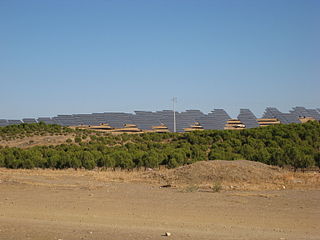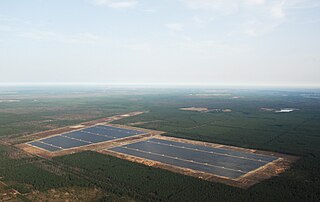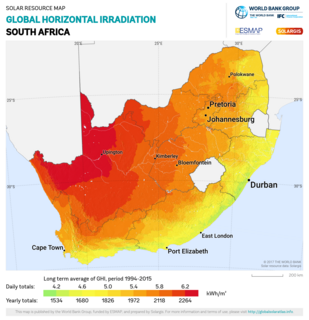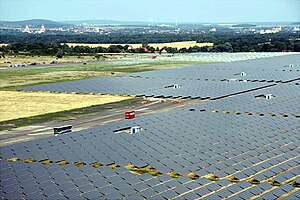
Many countries and territories have installed significant solar power capacity into their electrical grids to supplement or provide an alternative to conventional energy sources. Solar power plants use one of two technologies:

Spain is one of the first countries to deploy large-scale solar photovoltaics, and as of 2018, is the first country for concentrated solar power (CSP) in the world.

Solar power in Germany consists almost exclusively of photovoltaics (PV) and accounted for an estimated 8.2 percent of the country's gross-electricity generation in 2019. About 1.5 million photovoltaic systems were installed around the country in 2014, ranging from small rooftop systems, to medium commercial and large utility-scale solar parks. Germany's largest solar farms are located in Meuro, Neuhardenberg, and Templin with capacities over 100 MW.

Solar power represented a very small part of electricity production in the United Kingdom (UK) until the 2010s when it increased rapidly, thanks to feed-in tariff (FIT) subsidies and the falling cost of photovoltaic (PV) panels.

Solar power is a growing source in the Portuguese energy mix. At the end of 2020, solar power installed capacity totalled 1.03 GW and represented 3.6% of total power generation in 2020.

The Moura Photovoltaic Power Station is a large photovoltaic power station in Amareleja, in the municipality of Moura, Portugal. It is one of the largest power stations of its kind, and is built in one of the sunniest regions in Europe. Its construction involved two stages: stage 1 was completed in 2008 after 13 months, and stage 2 was completed in 2010. The entire project exceeded a total cost of €250 million.
China is the largest market in the world for both photovoltaics and solar thermal energy. China's photovoltaic industry began by making panels for satellites, and transitioned to the manufacture of domestic panels in the late 1990s. After substantial government incentives were introduced in 2011, China's solar power market grew dramatically: the country became the world's leading installer of photovoltaics in 2013. China surpassed Germany as the world's largest producer of photovoltaic energy in 2015, and became the first country to have over 100 GW of total installed photovoltaic capacity in 2017. At the end of 2020, China's total installed photovoltaic capacity was 253 GW, accounting for one-third of the world's total installed photovoltaic capacity. Most of China's solar power is generated within its western provinces and is transferred to other regions of the country. In 2011, China owned the largest solar power plant in the world at the time, the Huanghe Hydropower Golmud Solar Park, which had a photovoltaic capacity of 200 MW. In 2018, it held the record again with the Tengger Desert Solar Park with its photovoltaic capacity of 1.5 GW. China currently owns the second-largest solar plant in the world, the Huanghe Hydropower Hainan Solar Park, which has a capacity of 2.2 GW. Solar power contributes to a small portion of China's total energy use, accounting for 3.5% of China's total energy capacity in 2020. General Secretary of the Chinese Communist Party and paramount leader Xi Jinping announced at the 2020 Climate Ambition Summit that China plans to have 1,200 GW of combined solar and wind energy capacity by 2030.
Solar power in California includes utility-scale solar power plants as well as local distributed generation, mostly from rooftop photovoltaics. It has been growing rapidly because of high insolation, community support, declining solar costs, and a Renewable Portfolio Standard which requires that 33% of California's electricity come from renewable resources by 2020, and 60% by 2030. Much of this is expected to come from solar power via photovoltaic facilities or concentrated solar power facilities.

The Lieberose Photovoltaic Park is a 70.8-megawatt (MW) photovoltaic power plant in Lieberose, Brandenburg, Germany. The solar park with 900,000 solar panels which went fully on line in October 2009, and will supply electricity for 15,000 households a year while reducing the use of pollution-generating fossil fuels. The Lieberose Solar Park cost $238-million and is operated by the Juwi Group, which has a 20-year contract on the land.
The Montalto di Castro photovoltaic power station is an 84 megawatt (MW) photovoltaic power station at Montalto di Castro in Viterbo province, Italy. The project was developed by the independent developer SunRay that was later acquired by SunPower. The park is the largest PV project in Italy, and among the largest in Europe.
The 12 megawatt (MW) Wyandot Solar Facility is a solar photovoltaic power plant completed in 2010, located in Salem Township, Wyandot County, Ohio. This system uses 159,200 panels spread over 83.9 acres (34.0 ha).

The Okhotnykovo Solar Power Station is a Photovoltaic power station in Crimea with installed capacity of 82,65 megawatts (MW). As of April 2012, it is the world's 6th largest solar plant and the second largest PV station in central and eastern Europe. The power station is located at Okhotnykovo in Crimea, Ukraine and was developed by the Austrian company Activ Solar. The first and second phases of the project were commissioned in July 2011, the third and fourth in October 2011.

A photovoltaic power station, also known as a solar park, solar farm, or solar power plant, is a large-scale grid-connected photovoltaic power system designed for the supply of merchant power. They are differentiated from most building-mounted and other decentralised solar power because they supply power at the utility level, rather than to a local user or users. The generic expression utility-scale solar is sometimes used to describe this type of project.

The Perovo Solar Park is a 100 MWp photovoltaic power station located at Perovo, Simferopol Raion, Crimea, Ukraine. As of July 2012 it is the world's fourth-largest solar farm, and is made up of 440,000 solar panels. It is owned by Activ Solar, and the final 20 MW stage was completed on December 29, 2011.

Solar power in South Africa includes photovoltaics (PV) as well as concentrated solar power (CSP). In 2016, South Africa had 1,329 MW of installed solar power capacity. Installed capacity is expected to reach 8,400 MW by 2030.

Solar power in Ohio has been increasing, as the cost of photovoltaics has decreased. Ohio installed 10 MW of solar in 2015. Ohio adopted a net metering rule which allows any customer generating up to 25 kW to use net metering, with the kilowatt hour surplus rolled over each month, and paid by the utility once a year at the generation rate upon request. For hospitals there is no limit on size, but two meters are required, one for generation, the other for utility supplied power.

Solarpark Meuro is a 166 megawatt (MW) photovoltaic power station located in Meuro and Schipkau, Germany. The plant was built on a former lignite mine and is the country's largest solar park. It was named POWER-GEN International solar project of the year in 2012.
Mount Signal Solar, also known as Imperial Valley Solar Project, is a 794 MWp (614 MWAC) photovoltaic power station west of Calexico, California, United States, in the southern Imperial Valley, near the Mexican border. The facility is being developed and constructed by 8minutenergy Renewables in three phases, with two completed as of 2018. At full build-out, it will be one of the world's largest PV solar farms with a capacity of about 800 MWp (600 MWAC). The project has been supported by several environmental groups, as the power station was built on low productivity farmland.

Renewable energy in South Africa is energy generated in South Africa from renewable resources, those that naturally replenish themselves—such as sunlight, wind, tides, waves, rain, biomass, and geothermal heat. Renewable energy focuses on four core areas: electricity generation, air and water heating/cooling, transportation, and rural energy services. The energy sector in South Africa is an important component of global energy regimes due to the country's innovation and advances in renewable energy. South Africa's greenhouse gas (GHG) emissions is ranked as moderate and its per capita emission rate is higher than the global average. Energy demand within the country is expected to rise steadily and double by 2025.
















